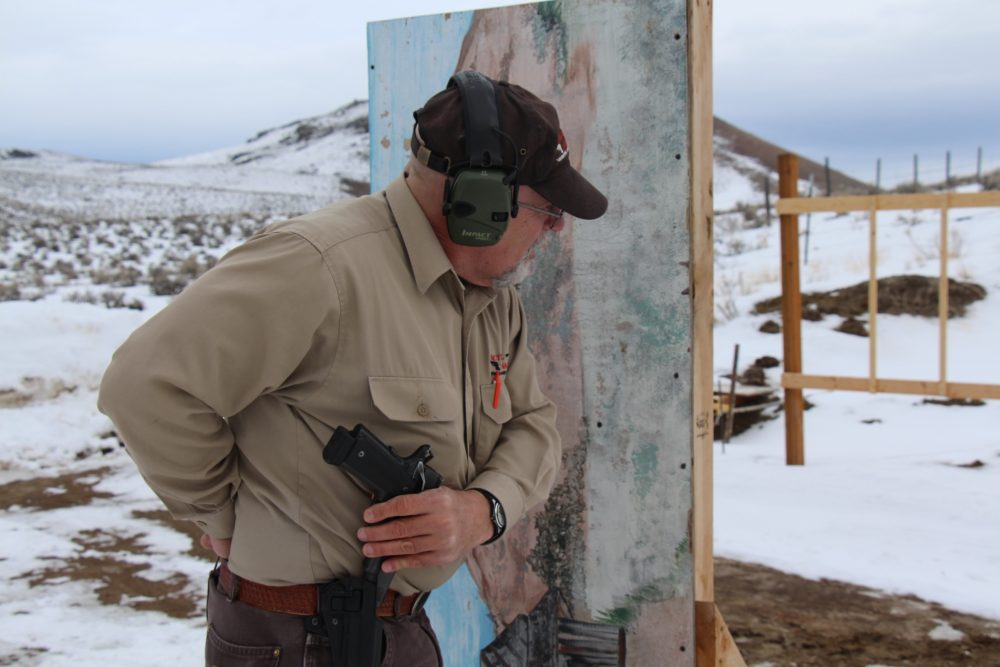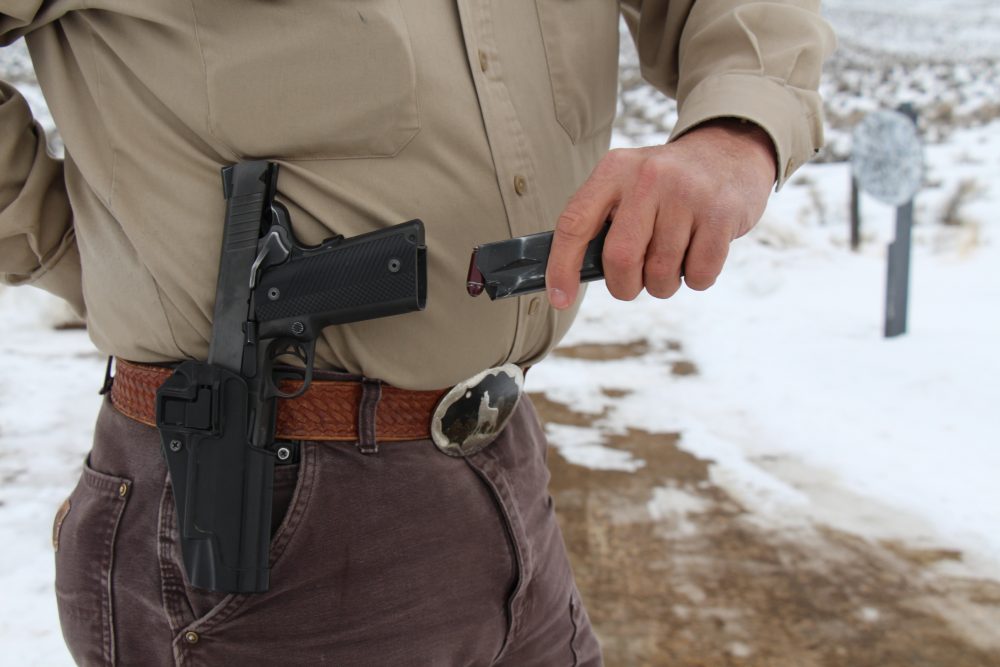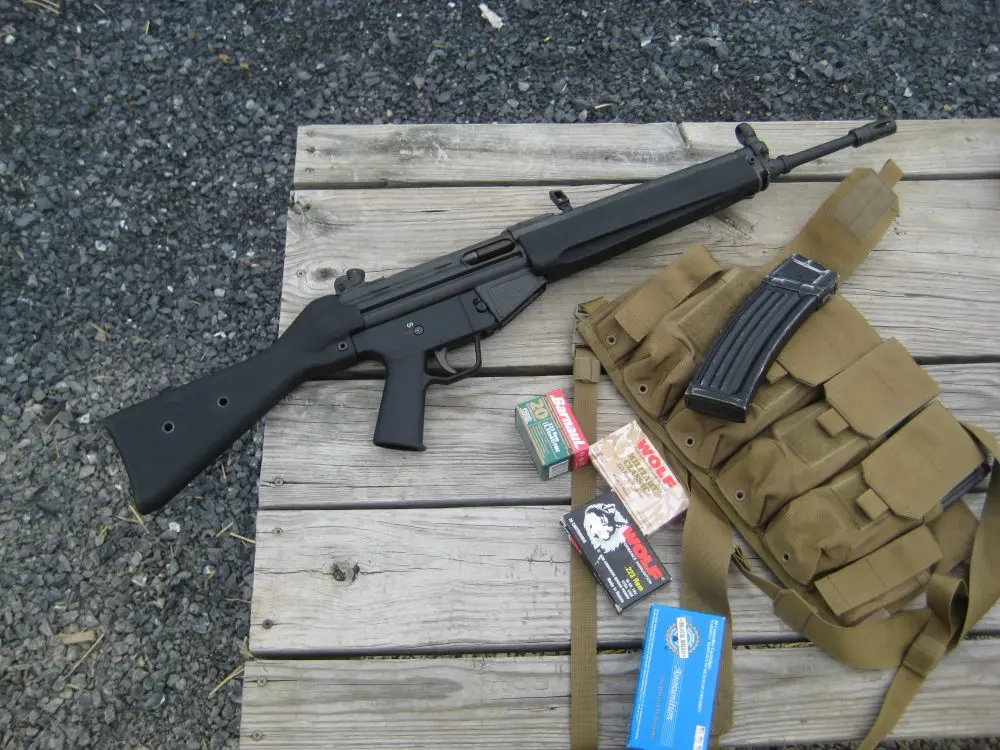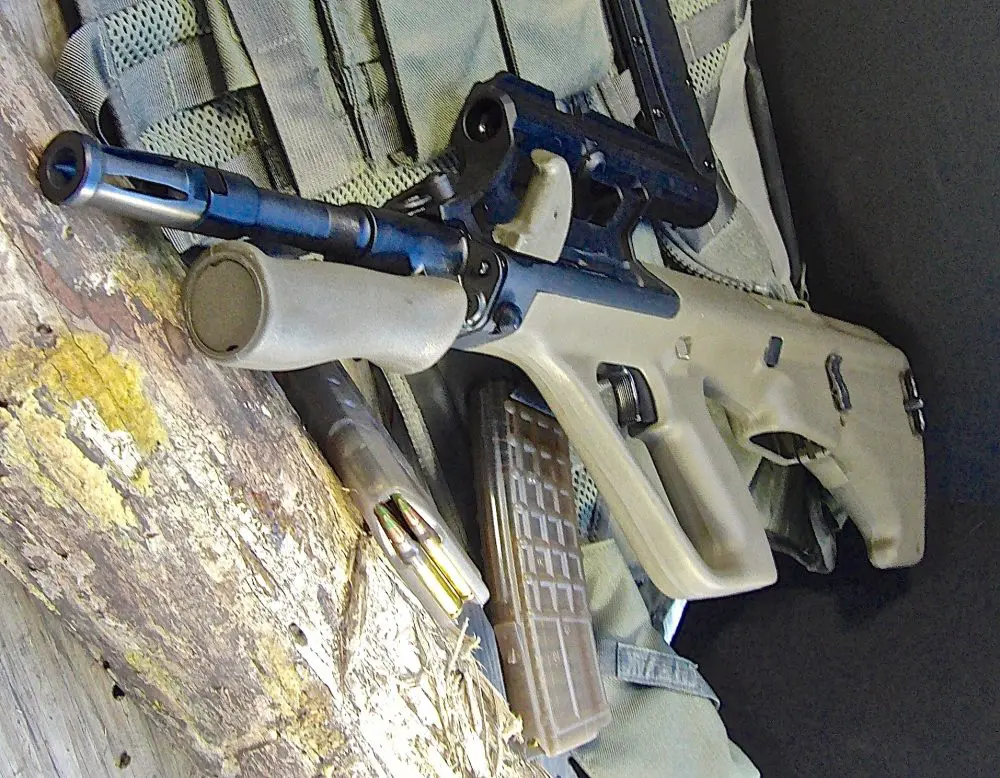In firearms training and practice, a danger exists of doing all manipulations with the idea that the extremities are all working, because at the range they are. But in an actual defensive encounter, one limb might become inoperable before the fight is over.
Although the chance of this is less likely than getting into a gunfight in the first place, possibly getting shot is part of the equation. You might also be walking around with a cast from an unrelated mishap or injure yourself falling or striking an opponent, and then you have to operate the defensive firearm in this condition.
Fortunately most gunshot wounds are not fatal, and the ones that are may not be fatal immediately, so the fight must go on. Wise pistoleros will consider this and add some drills to their routine before the situation becomes a reality. We do as we train!
Drawing weak hand behind cover. Strong hand is out of play. Keep an eye on the threat as you present the pistol.
Table of Contents
DRAWING THE FIREARM
The first key movement is getting the gun into play. Let’s say you are surprised by an active shooter and your strong-side arm takes the first hit. You instinctively go to cover, but the arm doesn’t work anymore. The action is still going and your gun is on the opposite side of your working hand. Can you get it out? Can you defeat the retention device? It will be in your weak hand being held from the slide. Can you turn it to a firing position and get it into the fight? Can you even shoot with your weak hand? Can you reload or clear a malfunction? These questions should be addressed prior to real-time incidents.
If you add this to your practice, work with the gun unloaded first. Reaching around to the off side to retrieve a pistol might put your fingers in the trigger area unintentionally. Work this out first with a safe weapon. This is important for both concealed carry and a duty rig.
If your weak hand is injured, drawing the weapon shouldn’t be much trouble, as your strong hand usually does this already. When the gun comes out with the weak hand, it will have to be turned to get a firing grip. It can be put between the knees to re-grip or put in the holster backwards.
Shooting weak hand only. A few rounds should be fired weak hand only and strong hand only every shooting session.
If you can’t get the pistol into action with the weak hand, a change in gear might be in order. Practice this during a dry-fire session while standing, seated in a chair, and sitting in a car, with and without a cover garment.
When I put my duty rig on, I retrieve the pistol with my weak hand once. If it is too far back and I can’t quite release the Serpa retention, I pull it around a bit to the front. This way it is in the right spot and I get weak-hand presentation at least once a shift. The same goes for my off-duty outfit.
If there is something close by to place the pistol on to correct my grip, I do it. If not, I do it by placing it backwards in the holster. Practice putting the pistol back in the holster with the weak hand.
Magazine change. Hold the pistol between the knees and look at the threat.
WEAK-HAND SHOOTING AND RELOADING
Now that the pistol is in the weak hand and presented on target, can you hit anything with it? Every session I include some weak-hand shooting to keep me in practice with what eye lineup I need and keep my weak trigger finger in shape. If you are not accustomed to the recoil with your weak hand, it could be a surprise when you shoot, so it needs to be practiced.
If your weapon is in your weak hand, the strong hand must retrieve a magazine if you’re in a gunfight where you have to reload. Oh, that’s right, the strong hand doesn’t work!
What are you going to do with the pistol while you get a fresh magazine? Also the empty magazine will have to be dropped with the weak-hand trigger finger because on most pistols—except those with an ambidextrous mag release—the magazine release will be on the wrong side, assuming you’re right handed.
If feasible, the pistol can be placed on the seat of the car if you are fighting around your vehicle, or on any flat surface, but sometimes those things aren’t handy. After I release the empty magazine with the weak trigger finger, I put the pistol upside down between my clenched knees. If you can reach it, the pistol can also be inserted backwards into the holster. Now the magazine well is facing up and a fresh magazine can be removed from the pouch and inserted into the well with a hearty rap.
Holster supports the pistol for magazine change. Dummy rounds are used.
Next you have to close the slide. With the handgun already in the knees, make sure the muzzle is pointing forward and not covering legs or knees, then pinch the rear of the slide with the knees and push the pistol out of the hold. Just a little back motion of the slide should release the slide lock, and the recoil spring will do the rest.
I like to release the slide and bring the pistol right back up to presentation in one move. If the pistol doesn’t close for whatever reason, I don’t try to do it again with the knees. I just find something else to push the slide against. Catching the rear or front sight or ejection port on the Kydex holster will do. You can use the edge of a car door, bumper, or most anything. Make sure the muzzle is pointing away from your body.
Use the ejection port to release the slide. Push sharply forward and away from the body to release the slide lock.
STRONG-HAND-ONLY MANIPULATIONS
If the weak hand becomes the victim, the strong hand will do the manipulations. This might be a little easier, but an extra magazine pouch should be where the strong hand can get to it to reload. Do you practice strong-hand-only shooting? Whatever you can do to support the pistol should be practiced.
The holster can also be used to hold the pistol while inserting the fresh magazine. If the strong hand is operating the weapon, it might be best to reholster normally and insert the magazine as you would in an administrative reload.
This also applies to revolver packers. With the open cylinder, it’s not really efficient to use the knees to support the weapon while reloading. One method is to put the barrel of the revolver in the front of the trousers with the cylinder opened out so the speed loader can be dumped into it or singles loaded. There will be some manipulation also to dump the empties out of the cylinder with one hand.
Using vehicle door jamb to close slide.
A little experimentation during dry-fire practice can really save time when seconds count. If you are carrying the revolver in an outside-the-belt holster, it might be possible to return the gun there with the cylinder open for reloading. Work it out!
When practicing this on the range, use an unloaded weapon to get the movements down, because these are life-or-death movements in a gunfight that is going wrong. This is not competition. Take your time and develop the skills. When practicing these techniques, slow speed and conscious effort are the ways to ingrain them.
The “injured” arm can be kept in the pocket while doing the manipulations or, as in our department training, it can be tied off during the exercise.
Pressing rifle against vehicle floor to charge it with one hand.
TRAINING SCENARIOS
In the last training scenario my department conducted, all one-handed manipulations were done around the patrol vehicle. The “injury” occurred while driving to the courthouse and someone who’d woken up hating the world decided to open up on us. The handgun was drawn and manipulated with the remaining good arm while moving around the vehicle and using it for cover. And it was set up so the officer would run out of ammo and have to do a reload mid-event.
While working around a vehicle, it’s easy to get so wrapped up in the one-handed loading or drawing processes that you can forget to keep an eye on the threat. If he is moving, you should be moving. If you are training with a partner, have him constantly remind you to watch and work.
Another scenario that was presented to us was, after attempting to return fire through the open door jamb or window, our firearm was struck by an offender’s round, damaging it and our strong hand. In this case, the problem becomes putting another weapon into play with the remaining limb.
Changing rifle magazine with one hand. Use unloaded weapon until you’re proficient at it.
LONG GUNS AND BACKUP GUNS
If you’re an officer, you might go for your patrol rifle or secondary weapon. A concealed carry citizen might not have a rifle in the vehicle but should have a second weapon. Anything you practice with the primary weapon you should practice with the secondary. If it is on your left ankle, practice the weak-hand draw and get it into play.
If you carry a long gun in your vehicle as a citizen, I am proud of you, but practice getting it into the fight. Most law enforcement carry a patrol rifle or shotgun locked in some sort of rack. Can you get it out with one arm? Can you shoot it with one arm?
Most of the time, the long gun is carried in “cruiser ready”: loaded magazine, empty chamber, safety off, which means it must be charged to get lead going in the right direction. Can you charge your rifle with one hand? Electronic sights are more difficult to turn on than just looking through the irons.
One good way to charge the AR platform is to place the muzzle into something that will not clog the barrel, like between the seat and the floor of the vehicle and lean on it with the butt in your shoulder.
This will hold it in place while the working hand charges it. If you need to get away from the door area of the vehicle and go to the back, the license plate area has some corners that the barrel can be held against. If you are forced to leave the vehicle, there are a lot of other things that can be used. The corner between the street and the curb, a wall—use your imagination and think of options before you need them.
This will also hold the carbine in place to reload a magazine if you have one. Oh, you don’t have an extra? Twenty-eight rounds should be enough in all but the most extreme situations, but what if you have a double feed and have to strip the magazine out and load a fresh one? Can you clear this with one hand?
Shooting the rifle weak hand unsupported. Try it from both sides.
Brownells carries magazine holders that attach to the buttstock or Picatinny rail and are a recommended attachment, along with a white light and sighting device. I keep a magazine anywhere I might be when fighting around the vehicle. Remember that magazines are expendable items. When it is empty, drop it. If it malfunctions in practice, replace it. They are not designed to last forever.
One final thing to work out with the rifle is shooting it one handed. Working around a vehicle offers many ways to rest the rifle and shoot it one handed, which is easier, but a rest may not be available.
Shooting the AR platform one handed with the strong hand may be difficult, but weak hand only is really challenging because it’s harder to hold up while lining the sights up with the non-dominant eye adding to the fun. Try it before you need it and figure out how you will do it.
Some of the ideas presented here are not the only way to get the job done, but are meant to get people in the survival mindset, thinking about the worst-case scenario and how to work through the challenges and survive.
SOURCE:
Brownells Inc.
(800) 741-0015
www.brownells.com















